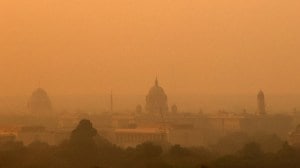‘Tankers spraying water near sensors at Anand Vihar’: AAP accuses BJP of manipulating pollution data
Hitting out at the party, the BJP denied the claims and calls it "politically motivated"
 Saurabh Bharadwaj; Manjinder Singh Sirsa
Saurabh Bharadwaj; Manjinder Singh SirsaAccusing the BJP-led government in Delhi of orchestrating a “massive pollution data fraud”, AAP on Saturday alleged that water was being sprayed day and night at the Anand Vihar ISBT pollution monitoring station “to artificially lower AQI (air quality index) readings”. The BJP dismissed the charge as “foolish” and “politically motivated.”
In a video released by AAP Delhi president Saurabh Bharadwaj, MCD tankers could be seen spraying water around the sensors at the ISBT station. He described this as “data management, not pollution control”.
“BJP Government — Pollution Data Fraud. Water is being sprayed day and night at the Delhi pollution monitoring station to reduce the pollution and AQI readings. These are the same people who say there is no dishonesty in EVMs. When they engage in dishonesty in everything, what can be expected from them?” he wrote on X.
Bharadwaj said MCD trucks were “circling around the station and spraying water continuously to make the pollution data appear lower than it actually is”. He alleged that “the theft was caught red-handed, so the trucks fled.” He further claimed that “those who are committing this massive fraud are the same BJP people who now occupy positions in Delhi’s government, MCD, and the Central government,” and that “huge quantities of petrol and water are being wasted— not to reduce pollution, but only to show lower pollution figures”.
Former Deputy Chief Minister Manish Sisodia and AAP MLA Sanjeev Jha also took on the BJP. “Pollute the air, dilute the data — hide the truth with water and mask the lie with make-up. This is the BJP’s pollution control model,” Sisodia said.
Jha remarked, “To ‘reduce’ Delhi’s pollution, BJP government has unveiled a new ninja technique — washing data instead of cleaning air.”
Environment Minister Manjinder Singh Sirsa, meanwhile, called the claims “foolish” and “politically motivated”. “They are liars of the highest order,” Sirsa said about AAP leaders.
MCD Mayor Raja Iqbal Singh also refuted AAP’s charges. “Water sprinklers are working everywhere and not from now but since last month. It is not just at this particular place… We cannot stop our work to mitigate pollution even if Saurabh Bharadwaj says so. In fact, he should appreciate that the corporation is doing such a great job.”
Data from the Central Pollution Control Board’s (CPCB) continuous air-monitoring station at Anand Vihar showed an unusual pattern on Saturday. Between 11 am and 12 pm — hours before Bharadwaj released the video of MCD tankers spraying water near the sensors at 3 pm — the PM10 concentration held steady at 736 µg/m³, before plunging sharply over next two hours to 291µg/m³ by noon. By 1 pm, PM10 had dropped to 221 µg/m³ — its lowest of the day — while PM2.5fell to 103 µg/m³ an hour later.
The decline was far steeper than what the other stations experienced during the same period, suggesting a localised effect around the Anand Vihar monitor rather than a city-wide improvement in AQI.
The data showed a quick rebound in the afternoon: PM10 levels surged back up by nearly 54% around 4 pm, coinciding with the tapering of the water-spraying activity.
Dr Manoj Kumar, air quality analyst at the Centre for Research on Energy and Clean Air, said the dip coinciding with the water-spraying activity mirrored the effect of rainfall on particulate readings. “Just like rain around the monitoring station, such surface wetting can temporarily suppress dust and lower PM readings,” he said, adding that the sharp fall observed at Anand Vihar could not reflect an actual reduction in pollution load across the area.
“This reduction did not last longer and just after the sprinkling stopped, the concentration increased. According to CPCB guidelines, monitoring stations should be located away from unpaved roads, heavy traffic, domestic chimneys, or major pollution sources, and the sampler must be more than 20 m from trees, Dr Kumar further said.
Delhi’s AQI is tracked through 40 continuous ambient air quality monitoring stations (CAAQMS) operated by the DPCC, CPCB, and IMD. These sites record real-time data on particulate matter and other pollutants, which are used to generate the city’s AQI. Among the monitoring stations, Anand Vihar is a major pollution hotspot as it generally remains the most polluted station of all, as per CPCB data.
The controversy erupted on a day when Delhi’s air quality once again worsened. According to CPCB’s 24-hour bulletin, the city’s average AQI on Saturday was recorded at 292 (Poor), up from 275 on Friday.







